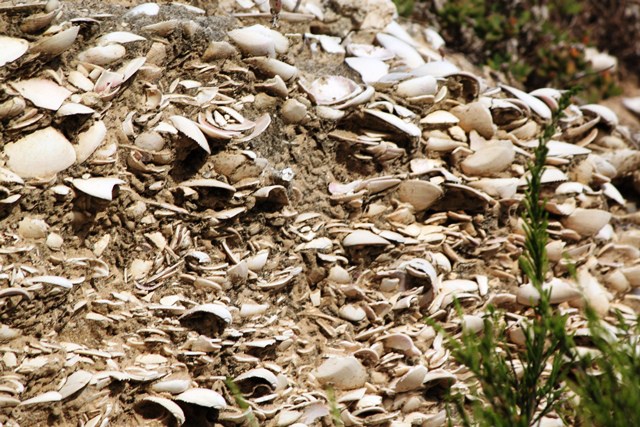SCORES & OUTDOORS: The shell-middens (what are they?) are trying to tell us something

shell-middens
 by Roland D. Hallee
by Roland D. Hallee
This week I’m going to give up this space to a subject of very much interest. It came across my desk last week, written by Alan G. Button, and it is something that I think I should share with you. It begins:
Three feet! I say again… THREE FEET BY THE END OF THIS CENTURY! This is the new alarming projection for sea level rise reported to us by the evening news over the last few weeks. Wake up people—Al Gore has warned us… TWICE! And scientists around the world, not influenced by politics and financial manipulation, all agree.
My interest (as a volunteer since 200l) has been to study prehistoric shell-middens, only a small number of some 2,000 existing along our often dangerous coastline. And they have been and still are disappearing at alarming rates. Over the last ten years I have witnessed the aftermath of total destruction to at least six middens within the Cushing, Friendship and Waldoboro coastal floodplains. And there is no exemption for what I see ahead.
Shell-Middens (sometimes called ‘kitchen middens’) are the remains of two basic time periods: the Ceramic Period people (precursors to the Wabanaki tribes of today) and the Late Archaics. Dates on rare occasion may range as far back as 5,000 B.P. (before present) which may include the Red Paint People. But most remains are of the four Ceramic Period divisions which terminated when European diseases wiped out upwards of 90 percent of these coastal families during the late 1520s.
Shell-Middens come in all shapes and sizes. But it is their content of bone, small pottery shards, charcoal, numerous lithic types, and various shell types which have only begun to help us understand these cultures. Many questions still remain: including migration and trade routes, hunting traditions, winter survival, and the extent of social life and cultural beliefs. The testing of one charcoal sample costs $250.00 or more. And the testing and analysis of faunal/soil material within a lab just for one site would be in the hundreds of hours.
Protection? Unlike other states, none exists. And unlike research and protection of historic sites funded directly by state legislation… Pre-historic field research performed by a handful of volunteers like myself has no funding. Where are the ‘Field Schools’? Where are the mandates to retrieve vital dateable faunal and charcoal remains? It baffles me, even with a ‘12,000 Year History of Prehistoric Maine’ exhibition within our Maine State Museum, just how many people (even our own legislators) who do not know or understand what shell-middens are nor what they represent.
And what boundaries, besides the lack of money, do we face? Three… Logistics and manpower, especially to offshore islands, ‘Potters’ who seem to believe valuable artifacts may still be found (rarely, and the damage they do is outrageous), and restricted access by landowners who have no
valid reason other than their own personal ideals. One such site on the upper Medomak River is reported to contain at least 800 cubic meters of intact shell/soil matrix. This site has never been sampled. And a 1983 report states a 115 meter (377 feet) wide erosion plain existed within the tidal margin below this midden.
I could think of several colorful adjectives one may apply to this mindset. Should we not demand some form of responsibility? Should not landowners be required to share these educational venues? Have we not learned any lessons from our past with knowledge that has been fragmented, obscured, altered or totally omitted?
I find it strange that when a bridge, culvert or road upgrade takes place at an inland stream crossover, it is a state mandate to have a licensed archaeologist on scene. Yet no such oversight exists for shell midden degradation.
Coastal towns are facing two major types of erosion: a) Wash-over from storm surge and b) Undermining of glacial till from tidal turbulence. The second is the most damaging as it involves subsurface whirlpools during flood-tides skirting in and out of coves and rivers, gouging and undercutting shorelines. Site 17.66 on the west shore of the St George River totally disappeared from undermining during the winter of 2016-17 (estimated to have been 20M x 6M x 25cm). I found nothing but shell hash scattered across the shoreline during a spring inspection in 2017.
What are we going to do? I do not place blame on the hardworking department heads and former state lab techs (where I volunteer) dedicated to conserving former research. But it’s going to take money, man-power, and a research center dedicated to a 10-20 year project to collect this information—something I had proposed some ten years ago. Perhaps, as so often happens, we will wait until it’s too late. And for many sites, it already is!
Let me know folks, only 60 years to go. This is your state… and your history.
Alan G Button is a volunteer with the Mid-Coast Shell-Midden Research; abfirewalker@gmail.com.
Roland’s trivia question of the week:
In 1967, Billy Rohr, of the Red Sox, pitched 8-2/3 hitless innings at the New York Yankees in his first major league appearance. Who got the hit that broke up the no-hitter?
Responsible journalism is hard work!
It is also expensive!
If you enjoy reading The Town Line and the good news we bring you each week, would you consider a donation to help us continue the work we’re doing?
The Town Line is a 501(c)(3) nonprofit private foundation, and all donations are tax deductible under the Internal Revenue Service code.
To help, please visit our online donation page or mail a check payable to The Town Line, PO Box 89, South China, ME 04358. Your contribution is appreciated!


Leave a Reply
Want to join the discussion?Feel free to contribute!